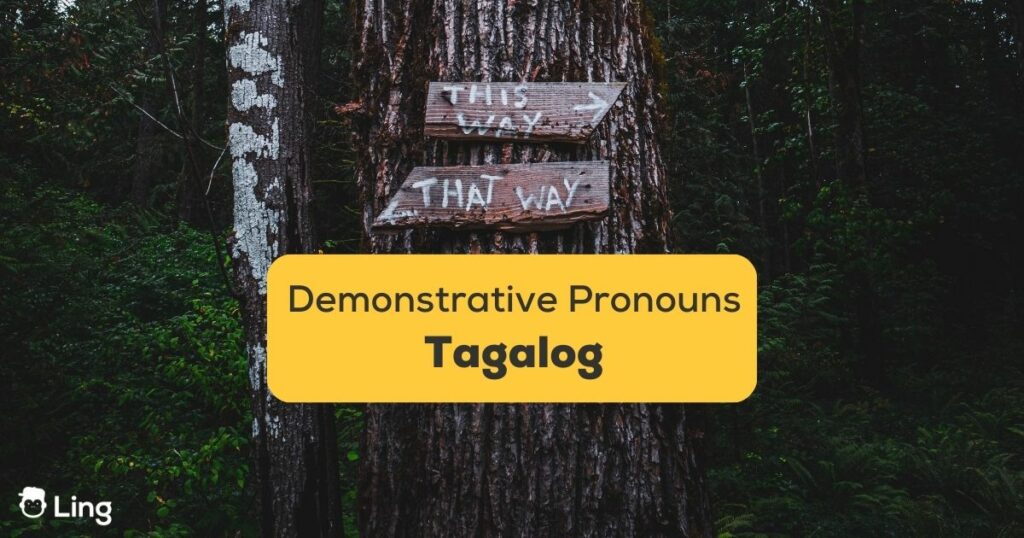Wondering why you should bother learning about the panghalip na pamatlig or demonstrative pronouns in Tagalog? Well, let me share a little secret with you! As a Filipino, I know how important it is for a beginner to understand the concept of pronouns.
You see, understanding demonstrative pronouns allows you to effortlessly navigate conversations, express your thoughts with precision, and connect on a deeper level with native Tagalog speakers. Ready to learn more Tagalog? Keep reading below!
Table of Contents

What Are Demonstrative Pronouns In Tagalog?
In Tagalog, there are literally different pronouns that you can use depending on the context. In the table below, we divided the commonly used demonstrative pronouns based on the proximal and distal forms.
| English | Tagalog | Context |
|---|---|---|
| This / Like this / Here / This | Ito / Ganito / Dito / Heto | When the object is near or being held by the speaker |
| That / Like that / There / That | Iyan / Ganyan / Diyan / Hayan | When the object is in close proximity to the speaker |
| That / Like that / There / There | Iyon / Ganoon / Doon / Hayun | When the object is far from the speaker |
In Tagalog, you have the power to take your demonstrative pronouns to new heights by adding affixes such as “-ng.” These affixes bring an incredible amount of depth and versatility to your sentences, allowing you to express yourself with precision. Let’s explore this linguistic magic with an example:
- Example: Ang mga librong iyan ay makakapal.
- Translation: Those books over there are thick.
By attaching the affix “-ng” to “libro” (book), you’re not only referring to some books but the particular books far from the speaker.

When Do You Use Demonstrative Pronouns?
Demonstrative pronouns in Tagalog are used in various contexts. Let’s take a closer look at how you can use these words and make your language skills shine!
Pointing To Objects
When you want to indicate or draw attention to a specific object, you can use demonstrative pronouns. For example:
- Ito ang paborito kong cellphone. = This is my favorite cellphone.
- Iyan ang kotse niya. = That is his/her car.
- Iyon ang bahay namin. = That is our house.
Referring To People
Demonstrative pronouns can also be used to refer to people, especially when you want to distinguish or identify someone. For example:
- Sino iyan? = Who is that?
- Kamusta ito? = How is this person?
- Iyon ang kaibigan ko. = That is my friend.
Demonstrating Location
If you want to indicate a specific location or direction, demonstrative pronouns can help. For example:
- Dito iyan. = That is here.
- Pumunta ka doon. = Go there.
- Iyon ang kanang kanto. = That is the right corner.
Emphasizing Comparisons
Demonstrative pronouns can also be used to emphasize comparisons or differences between objects or people. For example:
- Ito ang mas malaki. = This one is bigger.
- Iyan ang mas mura. = That one is cheaper.
- Iyon ang pinakamaganda. = That one is the most beautiful.
How Do You Say Demonstrative Tagalog Pronouns In Tagalog?
To say Demonstrative Tagalog Pronouns in Tagalog, you can say the phrase Panghalip na Pamatlig.
So what is Pronoun in Tagalog instead? In Tagalog, Pronoun is Panghalip.
Other Example Sentences For Demonstrative Tagalog Pronouns
Want to practice more? Take a look at some of these demonstrative Tagalog pronouns when used in Tagalog sentence structures.
If you want to learn more about Tagalog pronouns in general, you should use a handy language-learning app like Ling to help you. Ready to give this a try? Download it now from the Play Store or App Store!
Frequently Asked Questions About Demonstrative Tagalog Pronouns
Is Yung A Demonstrative Pronoun?
Yung is the Tagalog demonstrative pronoun with the equivalent English word That.
However, many people will interchange this word with the Tagalog article ang instead. Yung came from the combined word yun + the suffix ng.
What Is The Difference Between Demonstrative Tagalog Pronouns And Tagalog Possessive Pronouns?
Demonstrative Tagalog Pronouns indicate the distance or location of a Tagalog noun, object, or subject that the pronoun is referring to. Meanwhile, possessive Tagalog pronouns are used to show ownership or possession of a noun, object, or subject.
However, both of them may use particles or conjunctions when used in a sentence.
What Are Some Rarely Used Demonstrative Pronouns?
There used to be older Tagalog demonstrative pronouns that Tagalog native speakers use.
Some of these are:
- Iré or Irí, (This)
- Niré, Naré, or Nirí, (This)
- Dine or Dini (There)
While some of these words are considered older Tagalog demonstrative pronouns, people still use them sometimes. So why not try it yourself? However, you may sound like you’re saying a rarely used Tagalog word and many Tagalog speakers will think you’re not learning correctly. So only use these words with people you are really close with.
What Is A Demonstrative Pronoun?
Let’s take a refresher on what a demonstrative pronoun is.
In any language, pronouns or panghalip are those handy little words that replace Tagalog nouns to avoid repetition. They make our conversations smoother and more efficient. Technically, there are different types of pronouns, but in this post, we’ll focus on the type that helps us point out or refer to specific objects, people, or concepts.
In English, we use words like “this,” “that,” “these,” and “those” as demonstrative pronouns. For example, when you say, “This is my favorite book,” or “I want to buy that shirt,” you’re using demonstrative pronouns to indicate which book or shirt you’re referring to. See? They’re like your linguistic GPS, helping you navigate the vast world of nouns.
In Tagalog, demonstrative pronouns work in a similar way. They allow you to indicate the proximity or distance of the noun you’re referring to. By using the right demonstrative pronoun, you can be specific about whether something is close to you, close to the person you’re speaking to, or far from both of you. Below are some examples:
- Ito ang aking kapatid. = This is my brother.
- Iyon ang gusto ko. = That’s what I like.
- Heto ang bayad ko. = This is my payment.
So, in a nutshell, a demonstrative pronoun is a trusty language tool that helps you point, refer, and express proximity. It’s like having a linguistic finger that can precisely indicate the exact thing you’re talking about without having to repeat the noun over and over again.
Why Learn Demonstrative Tagalog Pronouns?
When it comes to learning Asian languages, many people tend to gravitate toward the more complex ones like Chinese, Korean, and Thai. And while those languages are certainly impressive to master, here’s a little secret: learning Tagalog can actually be a lot easier! Believe it or not, the Tagalog alphabet not only uses the familiar Latin alphabet, but its Tagalog grammar is surprisingly straightforward as well.
Imagine yourself strolling through the vibrant streets of Manila, confidently using the appropriate demonstrative pronouns to point out objects and places around you. Just picture the genuine smiles and nods of appreciation you’ll receive from the locals as you effortlessly blend in and communicate like a true Filipino. Sounds like a dream, right?
Exploring the world of demonstrative pronouns in Tagalog truly opens doors to authentic interactions and immersing yourself in the local culture.
Learn Tagalog With Ling
If you’re eager to continue your journey of learning Tagalog grammar, then it’s time to give Ling a try!
Ling is your ultimate language-learning companion, designed specifically to help you master Tagalog and explore its fascinating grammar intricacies. With its comprehensive and structured approach, this resource provides interactive lessons, quizzes, and games to make your learning experience enjoyable. Get ready to unlock the beauty of Tagalog, gain fluency, and impress others with your language skills.



































































